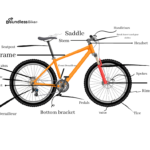Welcome to our blog where we’re going to answer one of the most asked questions in cycling: are bike brake pads universal? When it comes to replacing brake pads on your bicycle, you may wonder if you can use any type of brake pad or if there are specific ones designed for your bike. Don’t worry, we’ve got you covered! In this article, we’ll explore the world of bike brake pads and find out whether they are interchangeable between different types and brands of bikes. So sit tight and let’s dive into this topic together!
Are bike brake pads universal?
Yes, bike brake pads are universal. Different types of bikes may require different types of brake pads based on factors such as the type of brakes, the size of the wheels, and the intended use of the bike.
For example, road bikes typically use caliper brakes and require brake pads with a smooth surface, while mountain bikes may use disc brakes and require brake pads with a more textured surface. Additionally, there are different sizes and shapes of brake pads, so it’s important to make sure you select the correct brake pads that are compatible with your bike’s brake system.
It’s always best to consult your bike’s manufacturer or a bike mechanic to ensure you select the correct brake pads for your bike.
What are bike brake pads?
Bike brake pads are a crucial component of any bicycle, and they come in many different varieties to suit the needs of different cyclists. The most common type of bike brake pad is the rim brake pad, which attaches to the wheel rim and rubs against the tire to slow the bike down. There are also disc brake pads, which attach to a disc brake rotor and provide stopping power for disc brakes. Bike brake pads typically last for several thousand miles before they need to be replaced, but it is important to check them regularly for wear and tear.
Different Types of Bike Brake Pads

- Rim brake pads: Rim brakes are the most common type of brake found on road bikes, hybrid bikes, and some mountain bikes. They work by squeezing brake pads against the rim of the wheel to slow down or stop the bike. Rim brake pads are usually made of rubber and come in different compounds depending on the desired level of braking power, durability, and noise. There are also different shapes and sizes of rim brake pads to fit different rim widths and brake systems.
- Disc brake pads: Disc brakes are becoming increasingly popular on mountain bikes, gravel bikes, and some road bikes. They work by squeezing brake pads against a rotor mounted to the wheel hub. Disc brake pads are made of various materials, including organic compounds, metallic compounds, or a mixture of the two. Different compounds offer different levels of braking power, durability, and noise. There are also different shapes and sizes of disc brake pads to fit different brake systems and rotor diameters.
- Cantilever brake pads: Cantilever brakes are commonly found on cyclocross and touring bikes. They work by pulling on a cable that activates a set of brake arms, which push brake pads against the rim of the wheel. Cantilever brake pads are similar to rim brake pads in terms of material and shape, but they may have a different attachment method to fit the brake arms.
- V-brake pads: V-brakes are a type of rim brake commonly found on mountain bikes and hybrid bikes. They work by pulling on a cable that activates two brake arms, which push brake pads against the rim of the wheel. V-brake pads are similar to cantilever and rim brake pads, but they have a longer and more curved shape to match the shape of the brake arms.
It’s important to note that there may be variations within each of these categories depending on the specific brand and model of the brake system. Always refer to the manufacturer’s recommendations for the correct type, size, and shape of brake pads for your bike’s brake system.
How do bike brake pads work?
Bike brake pads work by creating friction against the rim or rotor of the wheel, which slows down or stops the bike. The brake pads are typically made of a rubber compound that grips the rim or rotor when pressure is applied. When the brake lever is squeezed, a cable or hydraulic system applies force to the brake caliper, which then presses the brake pads against the rim or rotor. The resulting friction slows down the rotation of the wheel, and the bike comes to a stop.
There are two main types of bike brake pads: rim brake pads and disc brake pads. Rim brake pads are located on the side of the wheel rim and are pressed against the rim to slow the bike down. Disc brake pads, on the other hand, are located on a rotor that is attached to the hub of the wheel. When the brake lever is squeezed, the brake caliper presses the pads against the rotor, creating friction and slowing the bike down.
Over time, the brake pads can wear down and become less effective at creating friction. It’s important to regularly check the brake pads for wear and replace them if necessary to ensure that the bike can be safely stopped.
Do all bikes use the same brake pads?
No, not all bikes use the same brake pads. There are different types of brake pads designed for different types of brakes and wheels. For example, bikes with rim brakes typically use brake pads that are designed specifically for use with rim brakes, and bikes with disc brakes use brake pads that are designed specifically for use with disc brakes.
Within each type of brake, there can be variations in brake pad size, shape, and material composition. For example, road bike rim brake pads are typically narrower than mountain bike rim brake pads to accommodate the narrower rims used on road bikes. Additionally, some brake pads are designed for use in wet weather conditions and are made of a different material that provides better grip in wet conditions.
When replacing brake pads, it’s important to use the correct type of brake pad for your bike’s specific brake system. Consult your bike’s owner’s manual or a bike mechanic to determine the correct brake pads to use for your bike.
How to choose the right brake pads for your bike?
- Determine what type of brake system your bike has: The two main types of brake systems are rim brakes and disc brakes. Rim brakes use pads that press against the rim of the wheel, while disc brakes use pads that press against a rotor attached to the wheel hub.
- Check the specifications of your bike’s brake system: Consult your bike’s owner’s manual or a bike mechanic to determine the correct size and shape of brake pads for your specific brake system. The correct size and shape of brake pads can vary depending on the type of brake system, as well as the brand and model of your bike.
- Consider your riding style and conditions: If you ride in wet weather conditions, you may want to choose brake pads that are specifically designed for wet conditions. If you do a lot of off-road riding, you may want to choose brake pads that are designed for the higher temperatures and more aggressive riding style of mountain biking.
- Consider your personal preferences: Different brake pads may have different levels of stopping power, noise, and wear. Consider what factors are most important to you when choosing brake pads for your bike.
Faq
You should replace your brake pads when they become worn down to the recommended minimum thickness, which is typically marked on the brake pad itself. You should also replace your brake pads if they become contaminated with oil or other substances, or if they develop cracks or other signs of damage.
You should consult your bike’s owner’s manual or contact the manufacturer to determine which type, size, and shape of brake pads are recommended for your bike’s brake system. You can also consult with a bike mechanic or salesperson at a bike shop for advice.
No, you should always use the type of brake pads recommended by the manufacturer for your bike’s brake system. Using the wrong type of brake pads can lead to reduced braking performance, increased wear and tear on your bike’s components, and potential safety issues.
You should inspect your brake pads regularly for signs of wear or damage. A worn brake pad will have a thin or uneven surface and may make a squealing or grinding noise when you brake. If you are unsure about whether your brake pads need to be replaced, consult with a bike mechanic or salesperson at a bike shop.
Conclusion
In conclusion, bike brake pads are not always universal and it is important to find the right type of brake pad for your specific bike. Whether you have a mountain bike or a road bike, it is essential to know what kind of brakes your bicycle has so that you can purchase the appropriate type of brake pads. With some research and patience, though, you can find the perfect fit for your braking system and enhance the performance of your ride.






